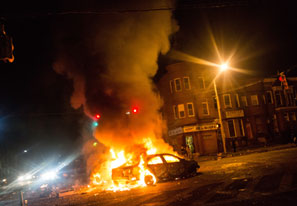
The apologetics began almost as soon as the fires were lit in Baltimore yesterday, heralding a night of violence and looting that would leave 24 police officers injured and 19 buildings torched, including a $16 million senior center providing affordable housing and a CVS drugstore providing crucial medications for elderly customers. Society “refuses to help [young blacks] in a serious fashion,” Michael Eric Dyson announced on MSNBC. “We’re only there when they riot.” Mika Brzezinski observed on Morning Joe: “This was an extremely, desperately poor city. This was bound to happen.” We were seeing an “uprising of young people against the police,” the result of a “combination of anger and disparity,” said professional talking head Wes Moore. Neill Franklin, a former Baltimore police officer and member of Law Enforcement Against Prohibition, blamed the drug laws.
In other words, the looters and arsonists were pushed to the breaking point by racism, poverty, and police brutality, the latter exemplified by the still unexplained death of Freddie Gray in police custody. The rioters’ means may have been regrettable, but they were engaged in a profound, if fiery, cri de coeur against the social injustice in which we all play a part.
Finally, a reason to check your email.
Sign up for our free newsletter today.
Bunk. What happened last evening in Baltimore was simply a larger and better-covered version of the flash mobs that have beset American cities for the last half-decade, in which black youths gather via social media to steal from stores and assault whites. In May 2012, for example, students from Mervo High School in Northeast Baltimore crammed into a 7-Eleven store that was offering free Slurpees as a promotion. The teens grabbed all the merchandise they could get their hands on—$6,000 worth in total—and fled from the store. The manager tried to close the door to prevent the thieves from escaping and was viciously beaten. On St. Patrick’s Day that same year, a flash mob converged on Baltimore’s Inner Harbor. The Baltimore Sun reported that by the time the rampage ended, “one youth had been stabbed, a tourist had been robbed, beaten and stripped of his clothes, and others had been forced to take refuge inside a hotel lobby to escape an angry mob.” Last April, a bicyclist in Baltimore was attacked by a group of black teens who knocked him off his bike and pummeled him.
Philadelphia, Los Angeles, Minneapolis, and Washington D.C., among other cities, have all grappled with similar violence. None of it deserves a righteous political gloss. Nor does the violence last night, which began with an invitation sent out over social media to convene at a local mall and “purge” it.
Perhaps if the media had not shrunk from reporting on the flash mob phenomenon and the related “knockout game”—in which teenagers tried to knock out unsuspecting bystanders with a single sucker punch—we might have made a modicum of progress in addressing or at least acknowledging the real cause of black violence: the breakdown of the family. A widely circulated video from yesterday’s mayhem shows a furious mother whacking her hoodie-encased son to prevent him from joining the mob. This tiger mom may well have the capacity to rein in her would-be vandal son. But the odds are against her. Try as they might, single mothers are generally overmatched in raising males. Boys need their fathers. But over 72 percent of black children are born to single-mother households today, three times the black illegitimacy rate when Daniel Patrick Moynihan wrote his prescient analysis of black family breakdown in 1965.
Baltimore councilman Brandon Scott came closest to the truth last night in a city news conference when he angrily called on adults to “get out there and stand up for your neighborhood . . . . Adults have to step up and be adults and control our future.” True enough. But primary responsibility lies with children’s own two parents. Pace Dyson, “we” have spent trillions of dollars since the 1960s trying to help black youth. A social worker and a government check are no substitute for a father and mother, however.
The same day that the student mob looted the 7-Eleven in 2012, eight people were shot in Baltimore in just 24 hours, a toll typical of Baltimore’s astronomical crime rate. Magnitudes more black men are killed by other black men in Baltimore and other American cities than by the police. But those killings are ignored, because they don’t fit into the favored narrative of a white, racist America lethally oppressing blacks. Police misconduct is deplorable and must be eradicated wherever it exists. But until the black crime rate comes down, police presence is going to be higher in black neighborhoods, increasing the chances that when police tactics go awry, they will have a black victim.
Baltimore’s response to the rioting yesterday was shamefully hesitant. The police stood by during the start of the arson, even as looters severed a fire hose brought in to try to save the doomed CVS store. Apparently, the ludicrous meme that the press promulgated after the August riots in Ferguson, Missouri—that the violence was provoked by a military-style police presence, rather than by the rioters themselves—has taken hold and inhibited police agencies from fulfilling their core duty to protect life and property. It is not clear whether the police diffidence yesterday was ordered by Mayor Stephanie Rawlings-Blake or by Police Commissioner Anthony Batts. But the next outbreak of mob violence should be greeted with the force that it deserves.